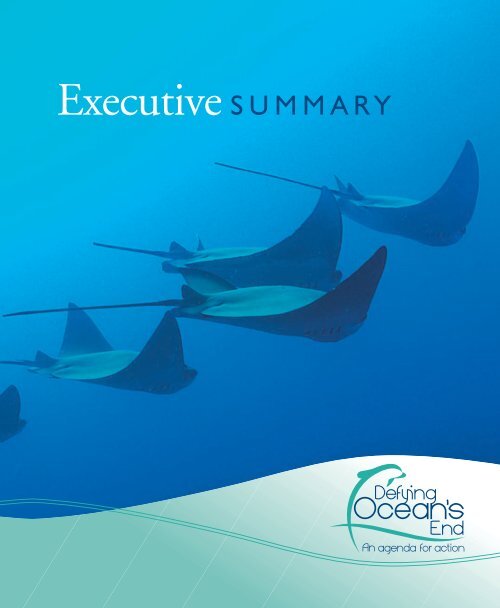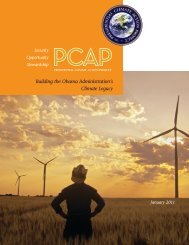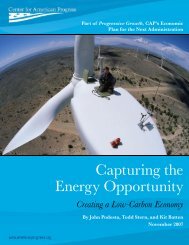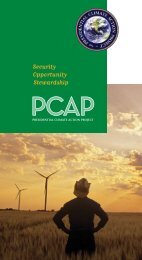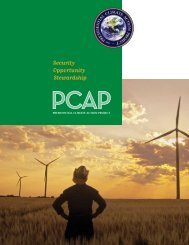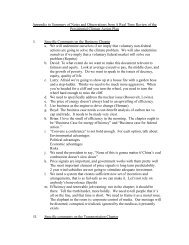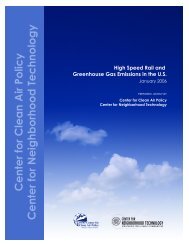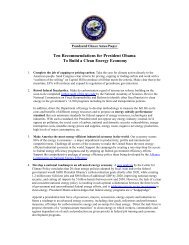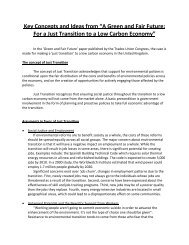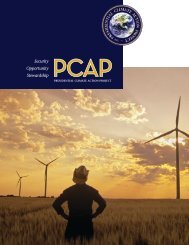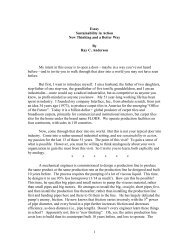Defying Ocean's End - Presidential Climate Action Project
Defying Ocean's End - Presidential Climate Action Project
Defying Ocean's End - Presidential Climate Action Project
You also want an ePaper? Increase the reach of your titles
YUMPU automatically turns print PDFs into web optimized ePapers that Google loves.
Executive SUMMARY
Executive SUMMARY<br />
MAY 29TH TO JUNE 3RD, 2003<br />
In recent years, human actions have had an unprecedented impact<br />
on the health of the oceans. A crisis is growing that threatens not only<br />
coastal communities that depend directly on living marine resources, but<br />
also all people everywhere. The Earth’s ocean is a unique feature in our solar<br />
system, and is essential for maintaining life on this planet.<br />
As never before, we are seeing the consequences of abuse in collapsing fish populations,<br />
biodiversity loss, and physical and chemical changes that are leading to the decline of entire<br />
ecosystems. As never again, we have an opportunity now to respond to this crisis, learn from<br />
centuries of experience in management of land, and move beyond localized and<br />
ad hoc initiatives — however good they may be — to coordinated global action.<br />
Our collective challenge is nothing less than the creation of a framework and steps for a practical agenda<br />
of global action — including costs and impacts — to safeguard the ocean for generations to come.<br />
Sincerely,<br />
Gordon E. Moore<br />
Sylvia A. Earle<br />
Photo © Jennifer Jeffers<br />
1
Overview<br />
THE CONCERN<br />
The ocean contains 97% of Earth’s water, drives climate and weather,<br />
shapes planetary chemistry, regulates temperature, generates more than<br />
70% of the oxygen in the atmosphere, absorbs much of the carbon dioxide,<br />
and replenishes fresh water to land and sea through formation of clouds<br />
bearing rain, sleet and snow. The ocean is home to most of the life on Earth,<br />
including nearly all major groups of animals, plants and microbes, comprising<br />
97% of the biosphere. A three-dimensional realm with an average depth of 2 1 /2<br />
miles — every drop filled with life — the ocean is a living system absolutely<br />
critical to how our world works. We are putting millions of tons of trash and<br />
toxic materials into the ocean and extracting millions of tons of wildlife from it<br />
each year. Urgent action is needed to address serious ocean concerns, but there is a profound lack of<br />
awareness of both the recent sharp decline in ocean health and the importance of the ocean to human<br />
survival. Without the living ocean, Earth would be as barren and inhospitable as Mars, but few understand<br />
that trouble for the ocean means trouble for humankind.<br />
THE APPROACH<br />
<strong>Defying</strong> Ocean’s <strong>End</strong> is the culmination of a yearlong<br />
effort that engaged a team of nearly 150<br />
experts from more than 20 countries to develop an<br />
approach to articulating a global plan of action.<br />
Ocean scientists, economists, conservationists and<br />
a select number of senior representatives from<br />
world governments, corporations and the media<br />
gathered in Los Cabos, Mexico May 29th to June<br />
3rd to build this plan. The DOE effort was structured<br />
into 5 regional case studies, 7 thematic working<br />
groups and a business team.<br />
The DOE Conference focused on developing action<br />
plans that address specific issues and outcomes —<br />
with priorities and costs identified — for 1-year,<br />
3-year, and 10-year timeframes. Five case studies,<br />
which addressed lessons learned and recommendations<br />
in very different regions, were presented to all<br />
Conference participants. Break-out discussions were<br />
divided into seven Thematic Working Groups on<br />
widely ranging science, conservation, social, economic<br />
and legal topics. These Theme Groups also interacted<br />
with the Business Team to identify key cost drivers and<br />
estimate reasonable total solution costs.<br />
SPONSORS The Gordon and Betty Moore Foundation • BP Corporation • Environmental Systems Research<br />
Institute (ESRI) • Royal Caribbean Cruise Lines • The Alexander Henry Foundation • An Anonymous Donor<br />
CONVENERS<br />
Photo © Jennifer Jeffers<br />
Gordon E. Moore • Sylvia A. Earle<br />
CHAIR Graeme Kelleher<br />
ADVISORS Dee Boersma • Scott Burns • Sarah Chasis • Anne Earhart • Gustavo<br />
Fonseca • Claude Gascon • J. Frederick Grassle • David Guggenheim • Lynne Hale •<br />
C. Wolcott Henry • Jeremy B.C. Jackson • Nancy Knowlton • Ghislaine Llewellyn •<br />
Laurence P. Madin • John McCosker • Ellen Pikitch • John Ogden • Callum M.<br />
Roberts • Scott Smith • Lisa Speer • Gregory Stone • Timothy B. Werner<br />
COLLABORATING INSTITUTIONS Center for Applied Biodiversity Science<br />
at CI • Conservation International • Natural Resources Defense Council •<br />
The Nature Conservancy • The Ocean Conservancy • Wildlife Conservation<br />
Society • IUCN – The World Conservation Union • World Wildlife Fund<br />
Photo © Jennifer Jeffers<br />
CASE STUDIES:<br />
▲ THE CARIBBEAN<br />
▲ SEAMOUNTS<br />
▲ ANTARCTIC WATERS<br />
▲ THE CORAL TRIANGLE<br />
▲ GULF OF CALIFORNIA<br />
THEMATIC WORKING GROUPS:<br />
▲ OCEAN-USE PLANNING AND MARINE<br />
PROTECTED AREAS<br />
▲ ECONOMIC INCENTIVES AND DISINCENTIVES<br />
▲ LAND-OCEAN INTERFACE<br />
▲ MAINTAINING/RESTORING FUNCTIONAL<br />
MARINE ECOSYSTEMS<br />
▲ COMMUNICATIONS<br />
▲ OCEAN GOVERNANCE<br />
▲ THE UNKNOWN OCEAN<br />
THE RESULTS<br />
A summary of the highest-level recommendations<br />
includes:<br />
▲ Global Governance: Treat the 60% of the world<br />
ocean outside of national Exclusive Economic<br />
Zones as a World Ocean Public Trust. Establish<br />
legal and implementation approaches concerning<br />
ocean uses in the high seas — including fisheries<br />
— under coordinated, international multi-use<br />
zoning regimes.<br />
▲ Fisheries Reform: Use market-based mechanisms<br />
and subsidy changes to reform fisheries<br />
through development of sustainable fishing<br />
programs, and the establishment of a global<br />
fund to provide incentives for the adoption of<br />
sustainable practices.<br />
▲ Communications: Implement global and<br />
regional communications plans to focus on<br />
educating the general public worldwide to<br />
ocean problems. Initiate global all-media<br />
campaigns on major issues. In developing<br />
Photo © Jennifer Jeffers<br />
nations, tailor the message to local cultural<br />
concerns and information networks (e.g.,<br />
tribal elders), and build local capacity for<br />
disseminating the message.<br />
▲ Marine Protected Areas/Large Marine<br />
Ecosytems: Create, consolidate and strengthen<br />
Marine Protected Areas (MPAs) into a globally<br />
representative network. Develop/implement<br />
coordinated, global Large Marine Ecosystem<br />
(LME) programs in identified priority regions.<br />
Provide more robust multi-use zoning and<br />
enforcement mechanisms to protect these<br />
LMEs. Establish LME/MPA protections over 5%<br />
of the world ocean within the next 10 years<br />
(0.7% currently).<br />
▲ Global Science: Develop an expanded applied<br />
research program focused on top priority marine<br />
environments high in endemism and biodiversity<br />
— seamounts, shallow- and deep-water reefs,<br />
continental slopes, caves and blue holes.<br />
COORDINATORS<br />
Linda K. Glover • Jennifer Jeffers<br />
2<br />
3
THE BUSINESS PLAN<br />
A team of business<br />
professionals worked<br />
with the theme groups<br />
to develop costs for the<br />
recommended strategies.<br />
The Business<br />
Team joined the theme<br />
group deliberations and<br />
assisted in organizing<br />
the recommendations<br />
into 1-, 3- and 10-year<br />
outcomes. The team<br />
then used the program development and costing<br />
experience of the theme group members to estimate<br />
significant cost drivers and total solution costs.<br />
There was considerable overlap among the<br />
recommendations of several of the seven theme<br />
groups and, to address this, the business team<br />
aggregated costs into implementation areas that<br />
are somewhat different from the Conference<br />
theme groups. The consolidated activity costs in<br />
these cross-cutting areas form the foundation of<br />
the preliminary cost model:<br />
▲ Global Science<br />
▲ Large Marine Ecosystems Programs<br />
▲ Marine Protected Areas<br />
▲ Fisheries Reform<br />
▲ Global Governance<br />
▲ Communications Plan<br />
▲ Program Coordination<br />
SUMMARY PROGRAM FINANCIALS (US$BILLIONS)<br />
CONFERENCE ACTION AGENDA First 3 Years 10 Year Total<br />
Global Science $0.32 $0.65<br />
Large Marine Ecosystems Programs $2.38 $9.32<br />
Marine Protected Areas $1.18 $5.42<br />
Fisheries Reform $0.17 $0.49<br />
Global Governance $0.14 $0.38<br />
Communications Plan $0.08 $0.44<br />
Program Communication $0.51 $1.93<br />
Total $4.78 $18.63<br />
Photo © Jennifer Jeffers<br />
The overall cost estimate for the practical action<br />
agenda is US$18.6 billion over ten years — a<br />
reasonable sum balanced against the much greater<br />
costs involved in inaction and further resource<br />
losses, and certainly reasonable compared to the<br />
more than $50 billion annually paid out by governments<br />
for “perverse subsidies” of various kinds that<br />
are actually supporting the catastrophic decline of<br />
life and health in the ocean.<br />
The immediate priorities are estimated to require<br />
an investment of approximately US$4.8 billion<br />
over the next three years. Some of these key activities<br />
can be executed as individual programs, but the<br />
power of the agenda is that these programs will<br />
support each other if implemented in a coordinated<br />
fashion. The table below outlines the short term<br />
and longer term costs for the agenda.<br />
This integrated cost model is preliminary and<br />
not comprehensive. The financial estimates should<br />
be considered reasonable only as an order of<br />
magnitude. For example, they do not include all<br />
activities and associated costs needed ultimately<br />
to protect the 20% to 30% of the global oceans<br />
recommended by many of the DOE experts.<br />
Rather, the plan focuses on the highest priority<br />
actions required in the next 3-year and 10-year<br />
periods. This initial model does not fully account<br />
for several significant cost factors:<br />
▲ The model includes programs to protect over<br />
twenty LMEs and four hundred MPAs that<br />
would together cover only about 5% of the<br />
world’s oceans, and the model contains only<br />
limited support for existing MPAs.<br />
▲ The plan assumes that all sustainable economic<br />
and community development costs created by<br />
establishment of LMEs and MPAs will be covered<br />
by current global aid programs.<br />
▲ The fisheries reforms will be piloted in only a<br />
few fisheries, and the plan assumes the global<br />
fisheries programs will be largely self-funded<br />
by leveraging current subsidy structures and<br />
expected economic benefits resulting from<br />
the reforms.<br />
▲ The cost model has not included resources to<br />
cover perpetuity costs for MPA operations, from<br />
trust funds for example, nor other potential<br />
revenue sources resulting from MPAs.<br />
▲ The general scope of recommendations and the<br />
resulting cost model do not allocate significant<br />
resources to address regional or global landbased<br />
threats.<br />
▲ The model also does not include the costs or<br />
revenue potential of aquaculture activities.<br />
▲ The plan assumes that enforcement costs,<br />
required to make LME or MPA management effective,<br />
will be covered by local government agencies.<br />
Two funding decisions were announced at the<br />
Conference:<br />
▲ There is an initial commitment of $5 million over<br />
five years from Conservation International to<br />
implement the agenda.<br />
▲ Conservation International and the Government<br />
of Indonesia signed a Letter of Intent to work<br />
collaboratively on marine conservation, resulting<br />
in a commitment of $1 million from the Global<br />
Conservation Fund for MPAs in Indonesia.<br />
NEXT STEPS<br />
▲ Follow-on meetings are planned for the leadership<br />
of NGOs and other organizations, with the aim of<br />
coordinating and implementing global initiatives.<br />
▲ The business team recommends further refinement<br />
of the costing and preparation of a broader<br />
business plan, to include:<br />
• Thorough vetting of some of the more novel<br />
action items.<br />
• Costs for ensuring expanded stakeholder involvement<br />
in many of these actions.<br />
• More rigorous revenue and funding plans.<br />
• Mechanisms for coordinating implementation<br />
across all participating groups.<br />
▲ Results of the DOE Conference will be summarized<br />
in a journal article, and a book will include details of<br />
the final reports and recommendations of each of<br />
the Case Study authors, Thematic Working Group<br />
teams, and the Business Team.<br />
▲ Final reports will be made available to all<br />
participating organizations.<br />
Photo © Wolcott Henry<br />
4<br />
5
Thematic Working Groups<br />
Ocean Use Planning and Marine Protected Areas<br />
Chairs: Dee Boersma & John Ogden<br />
Photo © CI, Sterling Zumbrunn Photo © Jennifer Jeffers<br />
6<br />
To develop a high-level, practical, global agenda for action in marine conservation, seven themes were<br />
chosen for the <strong>Defying</strong> Ocean’s <strong>End</strong> Conference that would cut across a wide range of traditional<br />
ocean issues. Seven Thematic Working Groups were formed in early 2003, with scientists, economists,<br />
legal, and communications experts from many countries. Before the DOE Conference, they outlined the<br />
major issues and drafted recommendations for their areas of expertise.<br />
AT THE CONFERENCE, THESE THEME GROUPS:<br />
▲ Heard the results — lessons learned and recommendations — from five<br />
very different regional Case Study areas (see page 14).<br />
▲ Were joined by additional experts who helped to refine their priorities and<br />
recommendations.<br />
▲ Were also joined by the Business Team that helped to develop the timing and<br />
costs of their recommended actions.<br />
▲ Were supported by a Geographic Information System (GIS) team for<br />
information analysis and display.<br />
Some of the maps, prioritized recommendations for action and costs are shown in the following pages.<br />
OCEAN-USE PLANNING & MARINE PROTECTED AREAS<br />
ECONOMIC INCENTIVES & DISINCENTIVES<br />
LAND-OCEAN INTERFACE<br />
MAINTAINING/RESTORING FUNCTIONAL MARINE ECOSYSTEMS<br />
COMMUNICATIONS<br />
OCEAN GOVERNANCE<br />
THE UNKNOWN OCEAN<br />
LARGE MARINE ECOSYSTEM (LME) AREAS HAVE BEEN OUTLINED IN SEVERAL GLOBAL SCHEMES. Despite the lack<br />
of clarity or agreement in LME boundaries, this group has proposed areas for near-term action.<br />
The concept of Ocean Use Planning recognizes<br />
that we must use the oceans, but can’t afford to<br />
use them up. It broadens the stakeholders from<br />
resource exploitation industries to society as a whole.<br />
We know enough now to begin a comprehensive<br />
long-term, ocean use planning process. We also<br />
know that if we do not act soon, the continued<br />
growth of coastal human populations combined with<br />
current use of marine resources will destroy any<br />
chance we have for sustainable use.<br />
This Theme Group used the Patagonian shelf as an<br />
example for discussing ocean-use zoning and costing.<br />
Group members have detailed knowledge of the area<br />
— the largest temperate continental shelf in the world.<br />
With its 2 million square kilometer extent physically<br />
bounded by the Brazil and Falklands/Malvinas<br />
Currents, and its enormous productivity, this region<br />
qualifies as an important Large Marine Ecosystem. A<br />
spreadsheet was developed outlining the required<br />
actions, timing and costs to implement an Ocean Use<br />
Plan for the Patagonian shelf ecosystem — $64 million<br />
for the first 3 years, $300 million over ten years.<br />
The overarching goal is global implementation of<br />
ecosystem management. Although some large scale<br />
marine ecosystems have been identified, there is no scientific<br />
agreement on where Large Marine Ecosystems<br />
management areas should be. Nevertheless, a preliminary<br />
list (see map) is proposed here for consideration.<br />
RECOMMENDED ACTIONS<br />
▲ Convene a group this year to identify the global<br />
large-scale ecosystems upon which management<br />
should be based.<br />
▲ Develop an appropriate system of governance<br />
that includes defining stakeholders and responsible<br />
parties for each unit managed. Within 3 years<br />
develop maps of priority areas for protection,<br />
with all current and planned uses and threats, to<br />
support zoning decisions in identified LME areas.<br />
▲ Develop/implement Large Marine Ecosystem<br />
(LME) ocean use and conservation plans, with<br />
zoning of areas for all commercial uses and<br />
protection goals. Implement a minimum of 5<br />
LME management programs in the next 3 years,<br />
and more than 20 in 10 years.<br />
▲ Include within the LMEs nested local plans<br />
for smaller-scale ecosystems (e.g. kelpbeds,<br />
seamounts). Develop programs for 80 existing and<br />
new Marine Protected Areas within 3 years, and<br />
more than 400 over 10 years, based on studies of<br />
the biology, uses and threats in each region.<br />
▲ Develop and pilot sustainable systems of reporting,<br />
surveillance, monitoring and enforcement, including<br />
deployment within 10 years of an Ocean<br />
Conservation Satellite System to support these goals.<br />
LEGEND:<br />
Large Marine<br />
Ecosystems proposed for<br />
high-priority attention:<br />
Benguela, Bering Sea, Baja<br />
Californian System (Baja and<br />
Sea of Cortez), Caribbean,<br />
Central West Pacific (Palau to<br />
Tuvalu), Convention for the<br />
Conservation of Antarctic<br />
Marine Living Resources<br />
(CCAMLR), Coral triangle<br />
(Tropical Indo-Pacific),<br />
Eastern Tropical Pacific (Costa<br />
Rican basin), Humboldt<br />
(Chilean/Peruvian) System,<br />
Patagonian, and Western<br />
Indian Ocean (East Africa).<br />
7
Economic Incentives and Disincentives<br />
Chairs: Andrew Solow & Jim Wilen<br />
The Land-Ocean Interface<br />
Chairs: Stephen Olsen & Alejandro Robles<br />
Photo © Sylvia A. Earle Photo © Kim Westerskov<br />
Global fishing approaches range<br />
from local subsistence fishing to<br />
industrial-scale deep trawling<br />
for orange roughy.<br />
Many problems concerning global marine<br />
capture fisheries can be traced to economic<br />
incentives to overfish and invest in excess capacity.<br />
A desperate “race to fish” often results. This<br />
contributes to catches above sustainable levels,<br />
adoption of destructive fishing gear, bykill of nontargeted<br />
species, and surprisingly little economic<br />
return. Farming on land “managed” in analogous<br />
ways — increasingly large harvesting equipment,<br />
no soil replenishment, no sowing of new seed —<br />
would be obviously ineffective and unacceptable.<br />
The solution required<br />
for global fisheries is<br />
wholesale reform of<br />
incentives, away from<br />
those promoting the<br />
race to fish. All approaches<br />
we discussed<br />
include some kind of<br />
dedicated harvest privilege,<br />
either to individuals or to groups, that guarantees<br />
a fixed share of some biologically sustainable<br />
target catch. Many such programs already implemented<br />
around the world in diverse fisheries have<br />
shown some success in meeting both conservation<br />
and economic development objectives.<br />
But fear of change — coupled with a lack of funding<br />
for education, consensus building, and implementation<br />
— continues to block implementation of more<br />
rational ways of managing precious marine<br />
resources. In developing countries, these obstacles<br />
are compounded by poor alternative employment<br />
opportunities, inadequate financial resources, and<br />
lack of management infrastructure and capacity.<br />
If fisheries are to be rationalized on a scale that will<br />
make a difference for the world ocean, a catalyst is<br />
needed that can overcome these obstacles. While<br />
forces are emerging independently in many areas that<br />
are tackling the symptoms and causes of global<br />
depletion of ocean resources, it is likely that large<br />
gains — in time, efficiency and effectiveness — are<br />
possible by joining forces, coordinating, and leveraging<br />
expertise and funding.<br />
RECOMMENDED ACTIONS<br />
▲ Establish a Global Fisheries Reform Fund<br />
within 3 years that is jointly financed by public<br />
and private sources interested in promoting<br />
marine conservation and biodiversity conservation.<br />
▲ Leverage funds — in many cases, redirect current<br />
subsidies — to overcome hurdles to reform, with<br />
the specific approach depending on the fishery.<br />
▲ Target candidate fisheries that promise both<br />
high environmental benefits and good financial<br />
returns from adopting rationalization schemes.<br />
▲ Review proposals and within 3 years implement<br />
pilot projects in 4 fisheries.<br />
▲ Develop within 3 years engagement strategies<br />
for an additional 100 fisheries.<br />
▲ By or before 10 years, obtain positive return<br />
from the initial pilot projects under the Global Fund<br />
and begin reinvesting in additional fisheries projects.<br />
This Group considered the Gulf of California<br />
(see page 19), as well as regional programs for<br />
the Great Barrier Reef, the Chesapeake Bay and<br />
the Wadden Sea, and concluded that governance at<br />
this scale can successfully address the root causes<br />
of coastal and marine degradation and instigate<br />
necessary changes in societal behavior. The group<br />
also recognizes that such regional efforts must be<br />
“nested” with those at municipal, provincial,<br />
national and global scales.<br />
An approach is proposed that avoids the weaknesses in<br />
many coastal management programs that have<br />
emerged since the Rio Conference in 1992: the<br />
absence of common frameworks for assessing<br />
progress and for disseminating innovations; the absence<br />
of funding to reward and sustain sound programs<br />
in low-income nations; and the absence of global<br />
mechanisms to encourage collaborative learning.<br />
RECOMMENDED ACTIONS<br />
Establish a Global Fund for Coastal Stewardship —<br />
not to initiate and finance stand-alone programs,<br />
nor create new organizations, but to recognize and<br />
support those that meet set standards for coastal<br />
conservation. The Fund will include formation<br />
within 3 years of:<br />
▲ Global standards of program accountability and<br />
transparency in management decisions, to be<br />
established as a Code of Conduct for the<br />
Stewardship of Coastal Ecosystems.<br />
▲ A Coastal Stewardship Incubator Network of<br />
approximately 20 regional programs, many<br />
rewarding successful programs in low-income<br />
nations that meet Fund standards, and having<br />
an established mechanism for “celebrating”<br />
these programs.<br />
▲ A global, but regionally grounded, knowledge<br />
network to disseminate successful practices.<br />
▲ A small to medium grants program for quick<br />
responses to emerging crises or high-priority<br />
opportunities.<br />
▲ A globally coordinated, but regionally grounded,<br />
public education program.<br />
Larger issues of watershed agricultural practices and<br />
man-induced global climate change were discussed,<br />
but funds needed to address them are not included<br />
in the integrated cost model (pages 4-5).<br />
Estimated cost of the Fund recommended here is<br />
$150 million for ten years, assuming $5 million per<br />
year for global collaborative learning and knowledge<br />
management and $0.5 million per year to sustain 20<br />
programs in the Incubator Network.<br />
Within 10 years, this focused approach is expected<br />
to produce numerous measurable outcomes in<br />
Incubator areas: restoration of depleted fish and shellfish<br />
populations; reductions in nutrient outflow from<br />
land and reduced risks of coastal eutrophication or<br />
“dead zones”; and coastal communities acting to<br />
modulate the behaviors that lead to coastal and<br />
marine degradation.<br />
Photo © Sylvia A. Earle<br />
8<br />
9
Restoring & Maintaining Marine Ecosystem Function<br />
Chairs: Les Kaufman & Jeremy Jackson<br />
Communications<br />
Chairs: Nancy Knowlton & John McCosker<br />
Marine ecosystems worldwide have been<br />
severely degraded by the effects of pollution,<br />
overfishing, and global climate change. Marine<br />
ecosystems respond to these combined insults by<br />
shifting from a state of high ratio of standing biomass<br />
to production to a low ratio. Accompanying this shift<br />
has been the loss of large animals, reduced biological<br />
diversity, and an astonishingly rapid degradation of<br />
complex underwater habitats such as coral reefs, sea<br />
grass and kelp beds. The losses herald a weakening of<br />
the self-restorative capacity of marine ecosystems,<br />
triggering a cycle of further decline.<br />
maintain those systems that are either intact or can<br />
be restored to good condition. <strong>Action</strong>s are recommended<br />
in every Large Marine Ecosystem worldwide,<br />
encompassing seven types of marine domain —<br />
tropical nearshore, temperate nearshore, estuaries,<br />
seamounts, polar seas, open ocean and deep ocean.<br />
The costs of the approach outlined below are integrated<br />
with those of other working groups in the<br />
business plan. Estimated costs of recovery for<br />
regional Large Marine Ecosystems will range from<br />
$500 million to $1 billion each over ten years.<br />
■ Within 3 years:<br />
Indonesia, Taiwan,<br />
China, Philippines,<br />
South Africa, Brazil,<br />
Jamaica, Ecuador<br />
■ Within 10 years:<br />
Japan, Gulf of Guinea,<br />
Mexico, India, Thailand,<br />
Argentina, Cuba,<br />
Far eastern Russia,<br />
East Africa/Kenya,<br />
Madagascar,<br />
The Red Sea<br />
Photo © Jennifer Jeffers<br />
AS ECOSYSTEMS<br />
DEGRADE, the amount<br />
of biomass for a given<br />
amount of biological<br />
production falls, and<br />
ecosystem complexity<br />
and integrity are<br />
undermined.<br />
Ecosystem Degradation<br />
Pristine<br />
B/P<br />
Man-induced Pressures<br />
Degraded<br />
Ratio:<br />
Biomass/Production<br />
The goal of this Group was to propose a scientifically<br />
sound program to reverse this decline in the vitality<br />
and functionality of marine ecosystems, and to<br />
RECOMMENDED ACTIONS<br />
▲ Prevent the spread of destructive fishing practices<br />
to remaining areas of ocean wildernesses;<br />
for example, ban trawling on most seamounts.<br />
▲ Create a global system of marine reserve<br />
networks to conserve representatives of intact<br />
marine systems.<br />
▲ Institute monitoring of the reserves as reference<br />
areas to separate natural from man-induced<br />
effects; include rapid large-scale mapping and<br />
monitoring of key biological processes.<br />
▲ Implement integrated ocean management using<br />
differences between impacted and reference sites<br />
to judge the effectiveness of management regimes.<br />
▲ Discover and create the environmental conditions<br />
conducive to marine ecosystem recovery. Develop<br />
a better understanding of the effects of pollution,<br />
global climate change, and bad watershed management,<br />
as well as the natural conditions that favor<br />
recruitment, strong year-class strength and<br />
system recovery.<br />
▲ Develop and apply new technologies to support<br />
interventions for accelerated ecosystem recovery.<br />
▲ Establish new, or employ existing, key institutions<br />
distributed among the major marine<br />
ecosystems of the world. Ensure these centers<br />
integrate research, monitoring, restoration and<br />
communication functions for their region.<br />
PROPOSED REGIONAL COMMUNICATIONS EFFORTS FOR MARINE CONSERVATION, to be implemented in two phases.<br />
“We don’t care about what we cannot see.”<br />
This is one of the most challenging<br />
aspects of addressing the state of the world’s ocean:<br />
to fundamentally change the attitudes toward the<br />
ocean that we have held for millennia.<br />
Widespread popular support is needed if marine conservation<br />
efforts are to be successful and sustainable.<br />
Conservation begins with people — they cause the<br />
problems and can help solve them. Consumers drive<br />
demand for sustainable fisheries. Coastal zone residents<br />
can insist on an end to upstream pollution.<br />
Constituencies drive policy-makers to adopt — or<br />
not — key regulations. Journalists set the agenda,<br />
create a sense of urgency, and inform the public<br />
about the problems, the causes and the solutions<br />
behind key issues in marine conservation.<br />
Marine scientists and conservationists must involve<br />
communications as an integral element of their<br />
strategies. With the help of communications professionals,<br />
we can launch a coordinated effort that<br />
produces a much better informed public — on a<br />
global scale — that changes mindsets, shatters the<br />
myth that the oceans are too vast to be irrevocably<br />
damaged, and advocates dramatic shifts in behavior.<br />
Public opinion polling for ocean issues is scarce. It does<br />
indicate, however, that people care about the ocean<br />
and its health, despite knowing very little, being often<br />
misinformed and largely unaware of the current degree<br />
of threat. Communicators must take advantage of the<br />
existing positive attitude, build awareness of the<br />
threats, and instill a sense of urgency in target audiences<br />
— policy-makers, consumers, industry and regional<br />
audiences — before widespread change can occur.<br />
RECOMMENDED ACTIONS<br />
▲ Launch a global marine conservation communications<br />
campaign within 3 years, addressing international<br />
policy and consumption issues, that will<br />
provide the context for regional and local efforts.<br />
For global outreach, use a combination of earnedmedia,<br />
paid media, electronic media and public<br />
service announcements distributed via the establishment<br />
of a World Ad Council for <strong>Defying</strong><br />
Ocean’s <strong>End</strong>. Focus on thematic “hooks” such<br />
as overfishing and habitat destruction, seamounts,<br />
land/sea interactions and ocean governance.<br />
▲ Establish a network of regional communications<br />
nodes and train local people as staff to ensure<br />
culturally appropriate communications approaches<br />
linked with local conservation efforts. For regional<br />
outreach, use a mix of earned-media, paidmedia,<br />
events, education and/or social marketing<br />
appropriate to each area. Launch regional efforts in<br />
8 countries within 3 years and in 12 additional areas<br />
within 10 years. (See map).<br />
10<br />
11
Ocean Governance<br />
Chair: Michael Orbach<br />
The Unknown Ocean<br />
Chairs: Larry Madin & Fred Grassle<br />
GLOBAL EXCLUSIVE ECONOMIC ZONE (EEZ) AND FISHERY ZONE (FZ) CLAIMS are widespread,<br />
but 60% of the world ocean still falls in largely unregulated “high seas” areas.<br />
12<br />
The ocean has historically been treated as a<br />
very different “policy space” from the land<br />
and the atmosphere. Governance structures for<br />
ocean resources and environments are underdeveloped,<br />
sector-specific, inconsistent, conflicting<br />
or non-existent.<br />
National jurisdictions over resources have recently<br />
(1970s-80s) been extended seaward 200 nautical miles,<br />
still leaving about 60% of the ocean as “high seas”<br />
for which there is no comprehensive policy or<br />
management framework. Significant ocean uses —<br />
pharmaceuticals, genetic resources, mariculture,<br />
wind, wave and geothermal energy — have no<br />
policy or management regime on the high seas or in<br />
national jurisdictions. Public trust principles well<br />
established for the land or atmosphere — economic<br />
rent for private use of public trust resources,<br />
performance or security bonds, public trust patent protections<br />
— have been little used for ocean resources.<br />
Past limitations in monitoring and enforcement of<br />
ocean governance regimes have been overcome by<br />
technology advances, but we must now develop the<br />
political will to commit resources to this task.<br />
RECOMMENDED ACTIONS<br />
▲ Initiate international discussions leading to the<br />
“policy enclosure” of the world ocean through a<br />
framework agreement addressing all human<br />
activities that affect the ocean, and<br />
providing for ecosystem-based, integrated,<br />
precautionary management<br />
of the high seas as a World Public<br />
Trust. Concepts that must be considered<br />
in this effort include:<br />
• Integration of governance regimes<br />
across use sectors, levels of government<br />
and the land-sea boundary.<br />
• Building scientific and policy<br />
capacity, especially in the lessdeveloped<br />
nations.<br />
• Comprehensive application of best<br />
available science, precautionary<br />
approach, “polluter pays” principles<br />
and public trust compensation<br />
(cost recovery and economic rent).<br />
▲ Ensure full consideration of major policy shifts in<br />
the international dialogue leading to a framework<br />
agreement:<br />
• Designating ocean living resources as “wildlife,”<br />
with a legal and policy framework analogous to<br />
those governing terrestrial and avian wildlife.<br />
• Shifting responsibilities for implementation and<br />
enforcement of ocean laws from flag and port states<br />
to an independent, verifiable international process.<br />
• Developing a decision-making process based on<br />
majority or super-majority voting, rather than<br />
consensus, for prompt international decisions.<br />
Using seamounts in the high seas as a specific<br />
implementation example:<br />
▲ Initiate emergency action, through a UN<br />
General Assembly Resolution, for a moratorium<br />
on bottom trawling until an effective management<br />
regime is established.<br />
▲ Within 3 years develop mechanisms through the<br />
Conventions on Biodiversity and Law of the Sea<br />
to select priority seamount areas and networks<br />
for protection, and implement some Marine<br />
Protected Areas with adequate monitoring and<br />
enforcement mechanisms.<br />
▲ Within 10 years develop an established, operational<br />
global network of high-seas seamount MPAs.<br />
source: NOAA<br />
This Group<br />
considered<br />
several poorly<br />
known ocean<br />
environments to<br />
determine needs<br />
Sea Fan 1<br />
for conservation<br />
action and/or research. Species-level data are<br />
lacking for many “unknown” habitats, and further<br />
basic research in these areas is important to conservation.<br />
But elsewhere, enough is known<br />
already to plan precautionary actions. In some<br />
instances, swift action is critical to avoid irrevocably<br />
losing many unknown ocean species before<br />
they can be discovered.<br />
RECOMMENDED ACTIONS<br />
▲ Initiate conservation action in 4 high priority<br />
“unknown” habitats, chosen based on: human<br />
impacts; potential irreversible loss of habitat<br />
type or biodiversity; adequate initial data; and<br />
economic feasibility of conservation actions:<br />
• Seamounts. Invest in a minimum of 45 ship<br />
days per year for 10 years for seamount<br />
sampling. Discover and research 10,000 new<br />
species within 10 years, and develop a global<br />
satellite-based surveillance system to enforce<br />
fishing restrictions on seamounts.<br />
• Deep, “twilight zone” coral reefs. Within 3<br />
years identify priority areas, do 4 reef area<br />
surveys, and develop a pilot project for conserving<br />
one site. Over 10 years survey an additional 10 or<br />
more sites and develop conservation strategies.<br />
• Continental slope, canyons, cold seeps.<br />
Complete ecological surveys of 3 seep sites<br />
within 3 years and determine changes there<br />
after 10 years.<br />
• Anchialine habitats — underwater caves and<br />
blue holes. Complete field studies of at least 10<br />
underwater cave environments in each major<br />
region of the world where they occur within 3<br />
years, and complete at least 90% of all known<br />
cave environments within 10 years.<br />
▲ Initiate research efforts in a second group of<br />
habitats with lower priority for immediate conservation<br />
attention, but warranting further<br />
research based on: high scientific or ecological<br />
value, inadequate initial data, no obvious immediate<br />
threats and opportunities for long-term<br />
conservation planning:<br />
• Prokaryote (microbial) ecology. Use new<br />
genetic tools to survey microbial diversity and<br />
processes, which are fundamental to the functioning<br />
of all ecosystems but poorly understood.<br />
• Open-ocean water column. Study this largest<br />
marine habitat, the source of most primary production<br />
and a vital link in the global cycles of carbon,<br />
heat, water and nutrients, and research the potential<br />
global effects of changes in these communities.<br />
• Deep benthos (bottom dwellers). Research this<br />
vast habitat that has exceptionally high biodiversity.<br />
• Ridge and vent systems. Study these<br />
chemosynthetic communities (not dependent<br />
on photosynthesis from the sun) for clues to the<br />
origin of life, and their unique adaptations to<br />
extreme temperature and pressure.<br />
• Frozen seas, ice edges. Study the important<br />
roles of these critical polar ecosystems and the<br />
potential effects of climate warming.<br />
• Fronts and upwelling zones. Research the effect<br />
of these areas on the survival of large pelagic (open<br />
ocean) fishes, reptiles and marine mammals.<br />
▲ Invest in improved data infrastructure to support<br />
both research and conservation, in particular the<br />
Ocean Biogeographic Information System (OBIS)<br />
of the Census of Marine Life. Establish new taxonomic<br />
authority groups, assess status of marine<br />
species through the IUCN Red List, and build<br />
OBIS to 25 million records within 10 years.<br />
1<br />
http://oceanexplorer.noaa.gov/explorations/02alaska/logs/jul15/<br />
media/paragorgia.html<br />
2<br />
http://oceanexplorer.noaa.gov/explorations/deepeast01/logs/sep26/<br />
media/anemone.html<br />
3<br />
http://oceanexplorer.noaa.gov/explorations/islands01/log/sep28/<br />
media/crablarvae.html<br />
4<br />
http://oceanexplorer.noaa.gov/explorations/deepeast01/logs/sep11/<br />
media/coralscape.html<br />
source: NOAA<br />
photo © Ifremer-Biozaïre2<br />
source: NOAA<br />
photo © Ifremer-Biozaïre2<br />
source: NOAA<br />
Deep Sea Anemone 2<br />
Deep sea mussel and worm beds<br />
Crab Larvae 3<br />
Close-up of deep sea shrimp<br />
and mussels<br />
Deep-sea corals 4<br />
13
Case Studies<br />
The Caribbean<br />
Mark Spalding & Phil Kramer<br />
Photo © Jennifer Jeffers<br />
Teams of DOE experts developed five regional case studies that were presented on the first day of<br />
the Conference. The areas are:<br />
■ THE CARIBBEAN<br />
■ SEAMOUNTS<br />
■ ANTARCTIC WATERS<br />
■ THE CORAL TRIANGLE<br />
■ GULF OF CALIFORNIA<br />
The Case Study areas were chosen not just for their differences<br />
in physical environment and levels of biodiversity, but<br />
also for their varying levels of degradation, types of threat,<br />
and sovereignty and governance regimes. The lessons<br />
learned and recommendations from these diverse case<br />
studies laid a broad foundation for the seven Thematic<br />
Working Groups that were charged with a global view.<br />
The modern Caribbean provides a microcosm of<br />
biodiversity, human impacts and governance issues:<br />
• Complex geologic history since the proto-<br />
Caribbean 130 million years ago prompted the<br />
evolution of a vast number of species found<br />
nowhere else — in extensive coral reefs, mangroves<br />
and seagrass beds, and in lesser known deep<br />
shelf ecosystems and partially isolated deep basins.<br />
• Human presence can be traced back over six<br />
millennia, but in the last 3-4 decades, this region<br />
has suffered considerably from human impacts —<br />
widespread overfishing; pollution (only about 10%<br />
of the region’s sewage is treated); and<br />
sediment runoff from coastal development.<br />
Disease outbreaks (region-wide death of branching<br />
corals and long-spined sea urchin) are indicative of<br />
an ecosystem already stressed by other factors.<br />
• There are 35 politically independent countries<br />
and territories, with independent sovereignty<br />
claims and marine conservation management<br />
schemes. Many issues require bilateral, regional<br />
or global collaboration.<br />
Despite these problems, the region incorporates<br />
numerous case-examples from which it is possible to<br />
develop a blueprint for recovery and sustainability.<br />
LESSONS LEARNED AND<br />
RECOMMENDED ACTIONS<br />
▲ Change mindsets; raise awareness with a targeted<br />
drive towards education at all levels.<br />
• Make fishermen aware of benefits to them of<br />
new approaches.<br />
• Educate tourists on ecologically responsible behavior.<br />
• Bring the marine environment into school curricula.<br />
• Give journalists compelling, science-based “stories.”<br />
• Target government and industry decision-makers<br />
using economic arguments.<br />
▲ Use the available science.<br />
• Encourage regional analysis of existing datasets.<br />
• Provide further training for Caribbean scientists<br />
and managers.<br />
• Pursue basic research in some high-priority<br />
remote areas.<br />
THE MANY CARIBBEAN NATIONS’ CLAIMS to Exclusive Economic Zones (EEZs)<br />
and Fishery Zones (FZs) complicate regional conservation schemes.<br />
▲ Improve management systems.<br />
• Disseminate examples like the Soufriere Marine<br />
Management Area in St Lucia and the Hol Chan<br />
Marine Reserve in Belize that demonstrate effective<br />
management improving both local livelihoods<br />
and biodiversity protection.<br />
• Implement more — and more effective —<br />
protected areas.<br />
• Include full stakeholder participation.<br />
• Consider local ownership of nearshore fisheries<br />
assets as a management approach.<br />
• Set targets: include 30% of nearshore habitats<br />
within no-take zones; install mooring buoys at all<br />
commercial dive sites and yacht anchorages;<br />
raise sewage treatment to 90%.<br />
• Establish park user fees to support management<br />
efforts.<br />
• Initiate active interventions where ecosystem<br />
function requires restoration.<br />
• Include innovative approaches for industrial<br />
involvement; balance punitive measures (“polluter<br />
pays” or “zero net loss” approaches) with<br />
positive incentives.<br />
▲ Work Internationally.<br />
• Encourage and support multi-lateral governance<br />
approaches.<br />
• Build up regional capacity through training and<br />
support of programs in poor or small nations.<br />
LEGEND:<br />
Accepted FZs<br />
Disputed FZ claims<br />
Accepted EEZs<br />
Disputed EEZ claims<br />
Territorial Seas<br />
High Seas<br />
14<br />
15
Seamounts<br />
Gregory Stone, Laurence Madin, Karen Stocks, Glenn Hovermale, Porter Hoagland, Mary Schumacher,<br />
Carolyn Steve-Sotka & Heather Tausig<br />
Antarctic Waters<br />
John Croxall & Phil Trathan<br />
SEAMOUNTS BIOLOGICALLY SAMPLED are shown in yellow; red indicates roughly 30,000<br />
seamounts estimated to exist in Pacific waters.<br />
Seamounts — underwater mountains and hills<br />
that rise at least 1,000 meters above the ocean<br />
floor — are distributed throughout the world’s<br />
ocean. Although only about 1,000 have been<br />
named, it is believed there may be over 30,000<br />
seamounts in the Pacific Ocean alone.<br />
Only about 220 seamounts have been sampled<br />
biologically, and well under half of these have been<br />
studied in any depth. What work has been done<br />
indicates seamounts support highly unique (endemic)<br />
faunas; on many seamounts 15-40% of all species<br />
collected are new discoveries to science.<br />
Commercial fisheries are the greatest current threat<br />
to seamounts. Newly developed fisheries for deepsea<br />
species are altering these habitats faster than they<br />
can be studied — and large pools of unknown marine<br />
biodiversity are being destroyed before they can be<br />
discovered. Advances in fishing technology in the<br />
1960s allowed trawling for deeper species, leading to<br />
the collapse of orange roughy and other species by<br />
the 1990s. Collateral damage from deep-sea trawling<br />
includes destruction of complex and poorly-known<br />
benthic (seafloor) communities. According to Koslow<br />
et al. (2001), unfished seamounts have almost 50%<br />
more species than fished ones, and only 10% bare<br />
rock compared to 95% bare rock on fished sites.<br />
Many species on seamounts are very long-lived and<br />
their biological communities can take hundreds, even<br />
thousands of years to develop. The<br />
accelerating collapse of conventional<br />
fisheries is stimulating further advances<br />
in deep-water fishing technology<br />
which will subject seamount populations<br />
to ever-increasing exploitation<br />
pressure.<br />
In Australia and New Zealand waters, a<br />
small percentage of seamount habitats<br />
have been protected and catch limits<br />
imposed, but developing fisheries<br />
elsewhere are largely unregulated. The<br />
legal framework for management of<br />
seamount resources is different in<br />
territorial waters, Exclusive Economic<br />
Zones (EEZs) and international waters.<br />
Most seamounts are in international waters, where a<br />
complex array of treaties applies, but there is no<br />
agreed mechanism for creating Marine Protected<br />
Areas in international waters.<br />
LESSONS LEARNED AND<br />
RECOMMENDED ACTIONS<br />
There is now an urgent need to discover, explore and<br />
find means to protect seamount environments before<br />
many more are destroyed. Specific steps will include:<br />
▲ Establishing a comprehensive global reserve system<br />
to protect representative seamount habitats<br />
throughout the world.<br />
▲ Initiating a comprehensive effort to bring together<br />
existing international research on seamounts, to<br />
guide placement of reserves and future sampling<br />
of under-represented seamount areas.<br />
▲ Requiring modifications of fishing gear to decrease<br />
impacts to habitats and marine mammals.<br />
▲ Basing stock assessments on techniques appropriate<br />
for deep-sea species.<br />
▲ Launching public information programs to<br />
inform consumers about the ecological dangers<br />
of deep-sea fishing; encourage the public to<br />
influence demand for these vulnerable species<br />
by electing not to purchase them.<br />
The Convention for the Conservation of<br />
Antarctic Marine Living Resources (CCAMLR)<br />
was developed in the late 1970s, and came into<br />
force in 1982, following recognition that uncontrolled<br />
exploitation of species such as Antarctic krill<br />
would have unprecedented effects on many other<br />
species dependent on them for food — including<br />
the recovery of previously harvested species such<br />
as whales, Antarctic fur seals and some fin-fish.<br />
CCAMLR is established on three important concepts:<br />
harvesting should be sustainable; harvesting<br />
limits should take into account the needs of<br />
dependent species; and any changes resulting from<br />
harvesting should be reversible within 30 years.<br />
The Convention develops management advice within<br />
an ecosystem framework, and has adopted a “precautionary”<br />
approach. Management is achieved through<br />
conservation measures, agreed by consensus, which<br />
the Member nations then enact, implement and<br />
enforce. Data collection, analysis and modeling<br />
programs are developed by the Scientific Committee<br />
and Working Groups of CCAMLR and are largely<br />
funded through national research agencies.<br />
Current CCAMLR experience with major Antarctic<br />
fisheries highlights the need to: understand factors controlling<br />
variability in stock distribution and abundance;<br />
characterize “functional relationships” between stock<br />
abundance and dependent species performance; identify<br />
appropriate monitoring variables; identify overlap<br />
between predators and commercial harvesting; understand<br />
conditions where dependent species may switch<br />
to alternative prey; identify management measures<br />
where a dependent species may also be harvested;<br />
minimize by-catch and incidental mortality of non-targeted<br />
species; and influence the management of<br />
species also harvested outside of CCAMLR jurisdiction.<br />
Two significant challenges are to eliminate illegal,<br />
unregulated or unreported fishing (IUU), and to<br />
ensure that adjacent Regional Fishery Management<br />
Organizations (RFMOs) adopt and apply comparable<br />
environmental and resource management standards.<br />
Despite these concerns the CCAMLR Experience,<br />
which now involves 24 nations as full members, serves<br />
as a promising model for global ocean management.<br />
LESSONS LEARNED<br />
AND RECOMMENDATIONS<br />
Important steps for governments in addressing global<br />
marine conservation will include:<br />
▲ Outlawing “flags of convenience” and improving<br />
“flag state” controls.<br />
▲ Transferring appropriate management responsibilities<br />
to RFMOs.<br />
▲ Implementing the FAO draft International Plan<br />
of <strong>Action</strong> for IUU fishing with mandatory as well<br />
as voluntary measures.<br />
▲ Improving collection and dissemination of all<br />
relevant fisheries data.<br />
▲ Establishing compulsory vessel monitoring<br />
systems and effective port state inspection.<br />
▲ Improving international fishery protection systems.<br />
▲ Listing vessels in compliance and non-compliance.<br />
In regulated fisheries, governments will also need to<br />
ensure that all RFMOs — in a consistent, transparent<br />
and accountable fashion — adopt precautionary<br />
approaches to sustainable harvesting; fully protect<br />
the needs of dependent species; adopt methods to<br />
eliminate by-catch of non-targeted species; adopt<br />
minimum reporting standards of effort, catch and bycatch;<br />
and license only compliant vessels, linked to<br />
appropriate incentives and training schemes.<br />
THE CONVENTION ON<br />
CONSERVATION OF<br />
ANTARCTIC MARINE<br />
LIVING RESOURCES<br />
(CCAMLR) area of<br />
management is shown.<br />
photo © Photodisc<br />
16<br />
17
Source: G. Allen/CI<br />
The Coral Triangle<br />
Timothy B. Werner, Ghislaine Llewellyn, Rod Salm & Gerald R. Allen<br />
THE CORAL TRIANGLE, its general outline indicated by distribution of reef fishes.<br />
REEF FISH DIVERSITY<br />
Distribution by number of<br />
species within three families.<br />
115 - 152<br />
152 - 159<br />
159 - 170<br />
170 - 185<br />
18<br />
The geographic distribution of marine biodiversity<br />
varies greatly across the world ocean. In one<br />
striking area of the western Pacific — the waters of<br />
Indonesia, Malaysia, Papua New Guinea, Philippines, and<br />
Solomon Islands — many different kinds of marine<br />
groups attain their peak global richness. This region has<br />
only 35% of the world’s coral reefs, but is home to 77%<br />
of the world’s coral species, over 50% of all reef fishes,<br />
58% of tropical marine mollusks, and the highest diversity<br />
of mangroves, sea grasses and many other groups<br />
— an astounding level of diversity concentrated in less<br />
than 1% of the world ocean’s surface area. Moreover,<br />
large numbers of these species occur nowhere else,<br />
including 97 species of reef fishes endemic to Indonesia<br />
and more than 50 in the Philippines.<br />
This region, which has been called the “East Indies<br />
Triangle” or the “Coral Triangle,” is a global priority<br />
for conserving the biodiversity of coral reefs, other<br />
tropical marine environments, and globally unique<br />
high seas and deep-ocean communities.<br />
Marine Protected Areas (MPAs) are one of the most<br />
effective tools for marine biodiversity conservation,<br />
but — excluding the area covered by whale sanctuaries<br />
— they cover less than 1% of this region.<br />
With every indication that human practices causing<br />
marine biodiversity loss will continue, a major financial<br />
commitment and increased popular and political<br />
support for marine conservation are required<br />
immediately to avoid continuing losses in species,<br />
habitats and ecosystem functionality.<br />
LESSONS LEARNED AND<br />
RECOMMENDED ACTIONS<br />
▲ Maintain and restore Coral Triangle representative<br />
habitats and marine biodiversity with “functional<br />
seascapes”: large-scale marine areas including networks<br />
of “no-take” MPAs, with the surrounding<br />
coastal and marine areas managed sustainably.<br />
• Design MPAs and MPA networks in ways to<br />
increase the probability of marine biodiversity<br />
survival in the face of global climate change,<br />
coral bleaching and other catastrophic events.<br />
• Establish priority areas for MPAs on biodiversity<br />
grounds, but also consider the likelihood of success<br />
based on attracting critical local support.<br />
▲ Initiate improved incentives for establishment,<br />
maintenance and enforcement of MPAs:<br />
• Develop more fiscal incentives, such as creating<br />
conservation concessions.<br />
• Respond to government concerns for revenue<br />
loss from illegal fishing.<br />
• Demonstrate fishing benefits of MPAs to coastal<br />
communities.<br />
• Establish higher, but still commercially competitive,<br />
dive fees.<br />
• Communicate the results of cost-benefit analyses<br />
for different resource-use options.<br />
• Respect the economic and subsistence needs of<br />
local communities.<br />
• Give greater roles to agents as a complement to<br />
those of central governments.<br />
▲ Conduct more systematic biodiversity assessment<br />
and monitoring, including changes in biological<br />
composition as well as environmental<br />
condition of communities, and provide real time<br />
information to inform management responses.<br />
Gulf of California<br />
Maria Carvajal, Charlotte Boyd & Mauricio Cervantes<br />
The Gulf of California in northwest Mexico covers<br />
an area of 375,000 square kilometers. It has been<br />
called a “caricature of oceanography” because its<br />
oceanographic dynamics are dramatically exaggerated,<br />
with deep basins in its central and lower portions and<br />
some of the greatest tides in the world in its upper<br />
reaches. It contains over a hundred islands and offshore<br />
rocks, and strong upwelling of cold, nutrient-rich<br />
waters are evident along both its coasts. The great<br />
diversity of topographic and bathymetric features has<br />
produced a variety of habitats for marine life. Sixteen<br />
of its marine species are listed in the IUCN Red List as<br />
threatened or vulnerable. The Gulf’s high biodiversity<br />
levels, biological productivity, and 831 endemic species<br />
make it one of the Large Coastal Ecosystem (LCE)<br />
conservation priorities on the planet.<br />
In recent decades, natural resources have been<br />
depleted and new opportunities have stimulated<br />
demand, resulting in increasing risk of conflict both<br />
between and within different business sectors over<br />
resource use, especially in the absence of clear<br />
property rights and strongly enforced regulations.<br />
Among the greatest threats to the health of the Gulf of<br />
California region is poorly planned economic development.<br />
Government agencies, academic institutions,<br />
REGIONAL CONSERVATION AGENDA, coordinated among local, national and<br />
private sector, and conservation organizations are international organizations.<br />
addressing these issues by developing several regional<br />
initiatives for conserving the Gulf’s richness and providing a basis for sustainable<br />
economic development. Two relevant initiatives are the Coalition for the<br />
Sustainability of the Gulf of California which brought together more than 150 experts<br />
to establish regional biodiversity conservation priorities in 2001, and the establishment<br />
and operation of five new coastal and Marine Protected Areas.<br />
LESSONS LEARNED AND<br />
RECOMMENDED ACTIONS<br />
Collaborative inter-sectoral efforts to define solutions<br />
to threats are critical; improved governance structures<br />
are key to effective natural resource management;<br />
marine protected areas are useful to control open<br />
access and support fisheries management; negotiating<br />
behavior changes produces more long-lasting results<br />
than imposing the values of one group on another; and<br />
sustained progress towards measurable goals is made<br />
at the Large Coastal Ecosystem scale.<br />
LEGEND:<br />
Areas of shrimp trawling<br />
Existing and planned<br />
“Nautical Staircase” marinas<br />
Existing watershed and Marine<br />
Protected Areas<br />
Proposed new Marine<br />
Protected Areas<br />
Photo © Patricio Robles Gil/Sierra Madre<br />
RECOMMENDATIONS FOR REGIONAL CONSERVATION AGENDA<br />
(SEE MAP) ARE:<br />
▲ Improve management of protected areas.<br />
▲ Establish new marine protected areas.<br />
▲ Integrate management of priority coastal wetlands.<br />
▲ Reduce the shrimp trawler fleet and improve its fishing technology.<br />
▲ Reorient a regional tourism project (The Nautical Staircase).<br />
▲ Establish the Gulf of California Conservation Fund.<br />
▲ Articulate a common regional vision.<br />
19
Conference Participants<br />
<strong>Defying</strong> Ocean’s <strong>End</strong><br />
Suite 600<br />
1919 M Street NW<br />
Washington, DC 20036<br />
202/912-1277<br />
s.earle@conservation.org<br />
www.defyingoceansend.org<br />
Robin Abadia<br />
CONSERVATION INTERNATIONAL<br />
Julia Acuna<br />
CONSERVATION INTERNATIONAL<br />
John Adams<br />
NATURAL RESOURCES DEFENSE COUNCIL<br />
Gerry Allen<br />
CONSERVATION INTERNATIONAL<br />
Chris Anderson<br />
SAPLING FOUNDATION<br />
Ragnar Arnasson<br />
UNIVERSITY OF ICELAND<br />
Farooq Azam<br />
SCRIPPS INSTITUTION OF OCEANOGRAPHY<br />
Todd Baldwin<br />
ISLAND PRESS<br />
Ivan Barkhorn<br />
MERIDIAN STRATEGY GROUP, LLC<br />
Nancy Baron<br />
SEAWEB<br />
Jamie Bechtel<br />
CONSERVATION INTERNATIONAL<br />
Charles Betlach<br />
Juan Bezaury<br />
THE NATURE CONSERVANCY<br />
Dee Boersma<br />
UNIVERSITY OF WASHINGTON<br />
Charlotte Boyd<br />
CONSERVATION INTERNATIONAL<br />
George Branch<br />
UNIVERSITY OF CAPE TOWN<br />
Thomas Brooks<br />
CONSERVATION INTERNATIONAL<br />
Lauretta Burke<br />
WORLD RESOURCES INSTITUTE<br />
Scott Burns<br />
WORLD WILDLIFE FUND-US<br />
Rodrigo Bustamante<br />
CSIRO MARINE RESEARCH & CHARLES DARWIN<br />
RESEARCH STATION<br />
Kraig Butrum<br />
CONSERVATION INTERNATIONAL<br />
Louis Cabot<br />
CABOT-WELLINGTON LLC<br />
Claudio Campagna<br />
WILDLIFE CONSERVATION SOCIETY<br />
Jim Cannon<br />
CONSERVATION INTERNATIONAL<br />
Marielle Canter<br />
CONSERVATION INTERNATIONAL<br />
Maria de los Angeles Carvajal<br />
CONSERVATION INTERNATIONAL<br />
Ed Cassano<br />
OCEAN FUTURES SOCIETY<br />
Sarah Chasis<br />
NATURAL RESOURCES DEFENSE COUNCIL<br />
Penny Chisholm<br />
MASSACHUSETTS INSTITUTE OF TECHNOLOGY<br />
Lew Coleman<br />
MOORE FOUNDATION<br />
Jean-Michel Cousteau<br />
OCEAN FUTURES SOCIETY<br />
The Honorable Rohkmin Dahuri<br />
MINISTER FOR MARINE AFFAIRS AND FISHERIES -<br />
INDONESIA<br />
Neil Davies<br />
RICHARD B. GUMP SOUTH PACIFIC RESEARCH<br />
STATION<br />
Lloyd Davis<br />
UNIVERSITY OF OTAGO, NEW ZEALAND<br />
Susan Dawson<br />
SAPLING FOUNDATION<br />
Brian Day<br />
INTERNATIONAL INSTITUTE FOR ENVIRONMENTAL<br />
COMMUNICATION<br />
Guilherme Dutra<br />
CONSERVATION INTERNATIONAL<br />
Sylvia A. Earle<br />
CONSERVATION INTERNATIONAL<br />
Sara Everett<br />
DOE GIS SPECIALIST<br />
Exequiel Ezcurra<br />
INSTITUTO NACIONAL DE ECOLOGIA<br />
Enyuan Fan<br />
CHINESE ACADEMY OF FISHERY SCIENCES<br />
Robert Fine<br />
DOE INFO TECHNOLOGY TEAM<br />
John Francis<br />
NATIONAL GEOGRAPHIC<br />
Rodney Fujita<br />
ENVIRONMENTAL DEFENSE<br />
Karen Garrison<br />
NATURAL RESOURCES DEFENSE COUNCIL<br />
Claude Gascon<br />
CONSERVATION INTERNATIONAL<br />
Joe George<br />
DOE INFO TECHNOLOGY TEAM<br />
Kristina Gjerde<br />
ENVIRONMENTAL SOLUTIONS INTERNATIONAL<br />
Linda Glover<br />
GLOVERWORKS CONSULTING<br />
Barry Gold<br />
PACKARD FOUNDATION<br />
Edgardo Gomez<br />
UNIVERSITY OF THE PHILLIPINES<br />
Montserrat Gorina-Ysern<br />
AMERICAN UNIVERSITY<br />
Fred Grassle<br />
RUTGERS UNIVERSITY<br />
Dietmar Grimm<br />
MERIDIAN STRATEGY GROUP, LLC<br />
David Guggenheim<br />
THE OCEAN CONSERVANCY<br />
Lynne Hale<br />
THE NATURE CONSERVANCY<br />
Martin Hall<br />
INTER-AMERICAN TROPICAL TUNA<br />
COMMISSION<br />
Graham Harris<br />
FOUNDATION PATAGONIA NATURAL<br />
Jim Hauslein<br />
HAUSLEIN & COMPANY, INC.<br />
Hugh Hough<br />
GREEN TEAM ADVERTISING, INC.<br />
Tom Houston<br />
INTERNATIONAL SEAKEEPERS SOCIETY<br />
Jeremy Jackson<br />
SCRIPPS INSTITUTION OF OCEANOGRAPHY<br />
Jennifer Jeffers<br />
DOE CONFERENCE ASSOCIATE<br />
Aristides Katoppo<br />
SINAR HARAPAN DAILY<br />
Les Kaufman<br />
BOSTON UNIVERSITY<br />
Graeme Kelleher<br />
DOE CONFERENCE CHAIR<br />
Paul Kelly<br />
ROWAN COMPANIES<br />
Richard Kenchington<br />
CONSULTANT<br />
Peter Knights<br />
WILDAID<br />
Nancy Knowlton<br />
SCRIPPS INSTITUTION OF OCEANOGRAPHY<br />
Phil Kramer<br />
UNIVERSITY OF MIAMI<br />
Scott Kyllo<br />
DOE INFO TECHNOLOGY TEAM<br />
Zelinda Leao<br />
UNIVERSIDADE FEDERAL DA BAHIA<br />
Larry Linden<br />
GOLDMAN SACHS & CO<br />
Ghislaine Llewellyn<br />
WORLD WILDLIFE FUND-US<br />
Gaston Luken<br />
FORMER CHAIRMAN, GE CAPITAL MEXICO<br />
Carl Lundin<br />
IUCN-WORLD CONSERVATION UNION<br />
Larry Madin<br />
WOODS HOLE OCEANOGRAPHIC<br />
INSTITUTION<br />
Francois Martel<br />
CONSERVATION INTERNATIONAL<br />
Dan Martin<br />
MOORE FOUNDATION<br />
Rod Mast<br />
CONSERVATION INTERNATIONAL<br />
John McCosker<br />
CALIFORNIA ACADEMY OF SCIENCES<br />
Anne McEnany<br />
INTERNATIONAL COMMUNITY<br />
FOUNDATION<br />
Sheila McKenna<br />
CONSERVATION INTERNATIONAL<br />
Edmund McManus<br />
UNEP WORLD CONSERVATION<br />
MONITORING CENTER<br />
Roger McManus<br />
SPECIES SURVIVAL COMMISSION<br />
Cristina Mittermeier<br />
Russell Mittermeier<br />
CONSERVATION INTERNATIONAL<br />
Gordon and Betty Moore<br />
MOORE FOUNDATION<br />
Ken Moore<br />
MOORE FOUNDATION<br />
Lance Morgan<br />
MARINE CONSERVATION BIOLOGY<br />
INSTITUTE<br />
Yaya Mulyana<br />
DIRECTOR OF MARINE PROTECTED<br />
AREAS - INDONESIA<br />
Robin Murphy<br />
CONSERVATION INTERNATIONAL<br />
Ransom A. Myers<br />
DALHOUSIE UNIVERSITY<br />
David Obura<br />
CORDIO<br />
John Ogden<br />
FLORIDA INSTITUTE OF OCEANOGRAPHY<br />
Stephen Olsen<br />
UNIVERSITY OF RHODE ISLAND<br />
Michael Orbach<br />
DUKE UNIVERSITY<br />
Julie Packard<br />
PACKARD FOUNDATION<br />
Arthur Paterson<br />
NOAA<br />
Maria Louisa Pena<br />
DOE INFO TECHNOLOGY TEAM<br />
Ed Penhoet<br />
MOORE FOUNDATION<br />
Charles Peterson<br />
UNIVERSITY OF NORTH CAROLINA<br />
Brad Phillips<br />
CONSERVATION INTERNATIONAL<br />
Ellen Pikitch<br />
THE WILDLIFE CONSERVATION SOCIETY<br />
Steve Polasky<br />
UNIVERSITY OF MINNESOTA<br />
Marjorie Reaka-Kudla<br />
UNIVERSITY OF MARYLAND<br />
Callum Roberts<br />
UNIVERSITY OF YORK<br />
Alejandro Robles<br />
CONSERVATION INTERNATIONAL<br />
Patricio Robles Gil<br />
AGRUPACIÓN SIERRA MADRE, UNIDOS<br />
PARA LA CONSERVACIÓN<br />
Martha Rosales<br />
CONSERVATION INTERNATIONAL<br />
Roger Rufe<br />
THE OCEAN CONSERVANCY<br />
Enric Sala<br />
SCRIPPS INSTITUTION OF OCEANOGRAPHY<br />
Rod Salm<br />
THE NATURE CONSERVANCY<br />
David Sandalow<br />
WORLD WILDLIFE FUND-US<br />
Gabriel Larrea Santana<br />
GOBERNADOR DE BAJA CALIFORNIA SUR<br />
REPRESENTATIVE<br />
Mick Seidl<br />
MOORE FOUNDATION<br />
Peter Seligmann<br />
CONSERVATION INTERNATIONAL<br />
Myriam Sibuet<br />
IFREMER<br />
Mike Smith<br />
CONSERVATION INTERNATIONAL<br />
Anne Solbraekke<br />
MOORE FOUNDATION<br />
Andrew Solow<br />
WOODS HOLE OCEANOGRAPHIC<br />
INSTITUTION<br />
Mark Spalding<br />
CONSULTANT<br />
Karen Stocks<br />
SCRIPPS INSTITUTION OF OCEANOGRAPHY<br />
Greg Stone<br />
NEW ENGLAND AQUARIUM<br />
Jatna Supriatna<br />
CONSERVATION INTERNATIONAL<br />
Lee M. Talbot<br />
GEORGE MASON UNIVERSITY<br />
Martha Talbot<br />
Phil Trathan<br />
BRITISH ANTARCTIC SURVEY<br />
John Wesley Tunnell<br />
TEXAS A&M<br />
Tom Tusher<br />
Ben Vitale<br />
CONSERVATION INTERNATIONAL<br />
Anne Walls<br />
BP p.l.c.<br />
Sue Wells<br />
Tim Werner<br />
CONSERVATION INTERNATIONAL<br />
James Wilen<br />
UNIVERSITY OF CALIFORNIA, DAVIS<br />
Captain Bill Wright<br />
ROYAL CARIBBEAN CRUISE LINES<br />
Jim Wyss<br />
CONSERVATION INTERNATIONAL<br />
Dan Zimble<br />
ESRI<br />
20<br />
21
100% RECYLED PAPER<br />
50% POST CONSUMER<br />
PHOTO © CONSERVATION INTERNATIONAL, STERLING ZUMBRUNN


